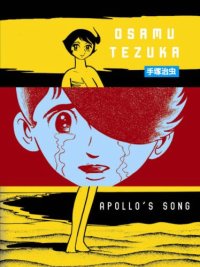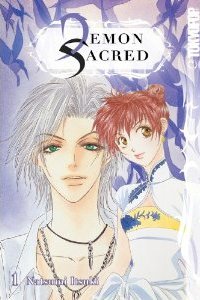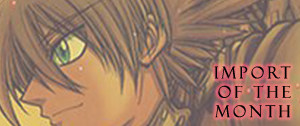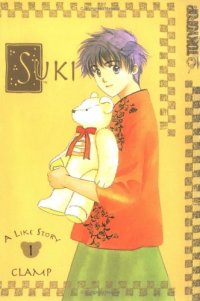RIGHT TURN ONLY!!
Apollo's Ramen
by Carlo Santos,

My friends, I have fallen in a deep and terrible hole. A hole known as Viewing All The New Fall Anime Series. Is there any escape from this pit of despair? Can my soul and sanity be saved? I suppose I can only know the answer after mid-October rolls around and I can rest my eyes once more ...
APOLLO'S SONG

Vol. 1
(by Osamu Tezuka, Vertical, $10.95)
FROM THE BACK COVER:
"Shogo has a mental problem that has created an uncontrollable hatred of love and sexuality. As a little child, Shogo witnesses his mother having numerous affairs with various men, while he never comes to know who his true father is. To compound his troubles, his mother never treats him affectionately; rather she repeatedly tells him that she never wanted him as her son. As a result, the young man lacks morality and ends up being a menace urged to kill anything that appears to feel love."
EVIDENCE FOR:
In this book: Osamu Tezuka goes craaaaaaazy with backgrounds! Yes, the man best known for cute, squishy characters proves that he also had plenty of talent to spare, dishing out landscapes that would challenge even today's artists and their modern tools. Every several pages is an explosion of natural beauty, with scenes like the lonely plains of war-torn Europe and a fictional tropical paradise (which includes an absolutely unforgettable sunset). But these places aren't just there to be admired; the simple yet dynamic page layouts also provide plenty of action as Shogo's story unfolds. Ah, right, the story—the real reason that Apollo's Song strikes such a resonant chord. With its mentally disturbed protagonist, surreal dream sequences, and deep meditations on the meaning of love and being human, this is the ultimate cure for folks who are tired of seeing the same manga about the same things over and over. The World War II scenario is already quite emotionally taxing, in that ill-fated romance kind of way, and then the tropical island vision—almost mythological and Biblical in scope—pushes that envelope even further. If you feel your brain and your heart haven't gotten enough exercise lately, Apollo's Song will fix that right up.
EVIDENCE AGAINST:
Despite being written by one of the all-time storytelling greats, this narrative just can't seem to get it together after Shogo's story breaks out into the real world. The first two (long) chapters are beautifully told, but are also set in Shogo's mind, giving Tezuka room to build his surreal imagery. By contrast, the final third of the book—where Shogo escapes a mental institution and meets a lady who lives in the hills—lacks the emotional heft of the earlier pages and doesn't seem to be going anywhere. Yes, the payoff surely comes in Volume 2, but there's still a drop in going from wartime tragedies and discovering the secrets of the beauty of life to ... well ... an escaped mental patient training to be an athlete in the backwoods. That stuff's just not as grand and philosophical. The artwork, too, leans too much on the cute-and-cuddly side sometimes, given the deep subject matter. Of course Tezuka wanted to be serious, but looking at those sparkly eyes and Disney hands, it's clear his natural drawing style just wouldn't let him.
FINAL VERDICT:
The first two chapters are pure artistic beauty—a real mind-opener. The latter part of this volume ... not so much. But the sheer depth and ambition is still worthy of a B+.
DEMON SACRED

Vol. 1
(by Natsumi Itsuki, Tokyopop, $5.99)
FROM THE BACK COVER:
"A mysterious, disturbing disease called Return Syndrome causing one to physically regress toward infancy and eventual death sweeps across the land. When Rina is infected with this rare disease, her sister Mona will go far beyond human means to save her! And when the inhuman comes in such gorgeous packaging, it might be hard to resist! Join Mona, K2, Rina, Mika and Shinobu as they fight against Return Syndrome, dark company secrets and enemies—both human and inhuman!"
EVIDENCE FOR:
In an unusual move, Volumes 1 and 2 of Demon Sacred are coming out at the same time, and if you want to know whether Volume 1 is good enough to carry on to the second as well, the answer is: yes. This melodramatic mix of sci-fi and fantasy clearly operates on a higher level than its peers, although that's to be expected coming from Natsumi Itsuki of Jyu-Oh-Sei fame. Challenging concepts like inter-dimensional beings and time dilation cross paths with raw, action-packed moments like demon summoning and spiritual energy transfer. Emotional currents also run strong in this one, with trans-generational drama involving two tragically fated twin sisters, a deceased mother, and the unconditional self-sacrifice of the man who loved her. It's a story that is very traditionally Romantic with a capital R, but also invokes heady scientific and literary concepts that give it surprising depth (including a reading straight out of the Book of Revelation). Meanwhile, others may simply latch onto this series for the alluring bishounen that feature in this story, and why not? With the sweet, delicate curves of Itsuki's throwback character designs, it's hard not to fall in love at first sight.
EVIDENCE AGAINST:
What do you call a manga that was released in the 00's, looks like the 90's, and spews out all the genre elements and unrealistic male stereotypes of the 80's and 70's? A mess, or in this case, Demon Sacred. Mixing and matching ideas usually breeds interesting results, but do it too much and you've got something that tastes like ketchup on chocolate: the characters blab on for ages explaining how the "demons" in this story aren't really demons, and how the medical condition of Reverse Syndrome is triggered by spiritual/trans-dimensional/we're-just-making-this-up circumstances, and how some arcane magickry might save Rina's life. It's a beautiful and complex world—except that the beauty can only be appreciated by sitting through mounds of expository dialogue. And if it's not techno-spiritual gobbledygook, it's the melodramatic lines coming out of everyone's mouths as they express their wild emotions like some kind of screaming soap opera. Just sit down and take a few breaths, guys. Visually, the overuse of screentones and gradients in the art also hampers the enjoyment, as all those patterned fields of gray do more to obscure the action than to highlight it.
FINAL VERDICT:
Well, the good thing is, you can by Volume 2 right away to see if the plot clears up! Unfortunately, this promising first volume trips over its own overambitiousness and finishes with a C+.
NEKO RAMEN

Vol. 2
(by Kenji Sonishi, Tokyopop, $10.99)
FROM THE BACK COVER:
"Look out for more outrageous ramen recipes as Taisho tries every gimmick in the book in order to make his restaurant the most successful cat-run business ever! Not only are there French chefs, curry, fortune-tellers, and cooking competitions, but Taisho's mother comes to visit and let loose Taisho's most embarrassing secret! What crazy scheme will Taisho cook up next?"
EVIDENCE FOR:
Few things are as disappointing as getting into a comedy series and realizing that all the good jokes ran out after Volume 1. Fortunately, Neko Ramen shows no such drop-off in its second volume, as it continues to succeed simply by doing what it did last time. Taisho's culinary explorations grow ever more ridiculous as he tries out new food offerings, with the best example being the "Neko Curry" concept that re-emerges every few chapters and pulls off a delightfully ironic twist at the end. There are even times when the best gags have nothing to do with food at all: Taisho's nutty business ideas stretch as far as opening a sideshow petting zoo, selling incorrectly prepared ramen from a "clearance outlet," and running a daycare (which he promptly cordons off as "No Children Allowed" because they're too noisy). The long-form chapters also explode with absurdist energy, allowing room for amusements like Taisho battling stray dogs with noodle strainers and a Yakitate!! Japan-style ramen competition. Forget all those inexplicably popular gag strips about cute girls doing cute things. Cute cats doing insane things is where it's at.
EVIDENCE AGAINST:
If Neko Ramen's second serving is all about matching the style and madness of the first, then that means the same problems carry over as well. Too often a joke ends up being run into the ground, to the point where the silliness stops being funny and starts being ... well, just silly. (All right, Taisho, you want to do photo-ops for the customers, we get it already.) On the converse side are jokes that, instead of being run into the ground, are just tossed into the air with no clear purpose—just what is the deal with Taisho's card-playing buddy Tetsu anyway? Either get him into a proper plotline (and yes, this series does sort of have plotlines) or stop shoving him in when you need to fill space. Also problematic, of course, is the crude artwork that limits the expressive possibilities for humor. After a while, it just gets old seeing Taisho make the same egotistical grin over and over, or Tanaka looking on in exasperation and shock as usual, or nameless faceless customers sitting at the counter. If you can barely draw the objects and situations featured in your comedy masterpiece, maybe it's time to take drawing lessons.
FINAL VERDICT:
It may have its share of rough spots, but the sharp and lively sense of humor redeem Neko Ramen's faults enough to lift it to a B.
SHIKI TSUKAI

Vols. 7-8
(by To-ru Zekuu and Yuna Takanagi, Del Rey, $17.99)
FROM THE BACK COVER:
"Akira is a Shiki Tsukai—a warrior who controls the seasons. He and his friends battle the Shiki Tsukai of Summer, who wish to destroy humanity. But Akira is new to his Shinra powers. Can he protect his team and the President from a sneak attack and save the world?"
EVIDENCE FOR:
It may be advertised as an action-packed blockbuster of calendar-based spiritual warfare, but the combined seventh and eighth volumes of Shiki Tsukai prove to be a whole lot more. The 300-page-plus omnibus is surprisingly well-balanced in its content, spanning the full emotional range from quiet tales of friendship to a heart-pounding battle that leaves an entire school in ruins. The first half of this book is the part that will appeal more to sensitive readers, with flashbacks that really flesh out the bonds of Akira and Fumiya's friendship, as well as other conversations between the main characters that establish them as true comrades and not just a bunch of magical warriors who kind of showed up in the same spot. By contrast, the latter chapters are sure to excite hot-blooded types, who will enjoy the all-out battle scenes, new powers and new combos, and the sense of urgency that comes with seeing one's friends in danger. Plus with the simple, fluid art style, every scene moves briskly, taking things ever deeper into this grand adventure.
EVIDENCE AGAINST:
The reason for bundling Volumes 7 and 8 of this series becomes clear after seeing that Volume 7 on its own would have caused an unprecedented number of deaths from boredom. While it's certainly important to establish the bonds of friendship and make the characters more relatable, stringing together that many chapters of wistful flashbacks and heartfelt dialogue, with no real action to break up the monotony, is just poor story planning. Even worse is that, amidst all this, it still has those awful interludes where the bad guys mutter a bunch of ominous-sounding lines to each other. When the villains finally do make a move—just before the start of Volume 8—it leads into this absolute mess of simultaneous battles between the series' overstacked pile of characters. The dads are running around doing one thing, while the kids are trying to protect the school, and no one can remember which of Akira's friends have shown up at the frontlines yet. The artwork itself further messes things up with plain, forgettable character designs, viewpoints and angles that only confuse the eye, and poor scene-to-scene transitions in combat. Apparently, moving from boredom to action only makes things worse.
FINAL VERDICT:
This series tries so hard to be taken seriously ... but the consistently sloppy execution and creatively bankrupt schoolkids-with-special-abilities concept earn nothing higher than a D.
TEGAMI BACHI: LETTER BEE

Vol. 3
(by Hiroyuki Asada, Viz Media, $9.99)
FROM THE BACK COVER:
"Amberground is locked in darkness. A man-made star casts only a dim light over the land. The pitch-black wilderness is infested with Gaichuu—colossal insects with metal exoskeletons. The Gaichuu make travel between the cities of Amberground extremely dangerous. But thankfully the Letter Bees, a brave corps of messengers, risk their lives in order to keep the hearts of Amberground connected.
Lag almost breaks the record time on his Letter Bee test, securing a job as a Letter Bee! But his celebration ends with unwelcome news: the record holder, his hero Gauche Suede, is no longer a Letter Bee! Shocked, Lag seeks out Gauche's little sister Sylvette to learn exactly what happened. But Sylvette has no answers, only memories and a broken heart."
EVIDENCE FOR:
So, you thought Tegami Bachi was just going to be a sparkly, steampunk-flavored Adventure of the Month where our hero Lag Seeing runs around making deliveries? Think again! Volume 3 is where the plot really starts to thicken, as the inexplicable disappearance of Gauche Suede opens up many new threads of intrigue. Among other things, Lag's ability to unlock memories trapped inside objects provides a clever built-in flashback mechanism. With this solid back story, the series now sets up the potential for much greater complexity. However, the last chapter of the book—where Lag is tasked with a very unique delivery—also reminds us of the series' more simple pleasures, like the joy of exploration and the emotional fulfillment that comes with bringing people together. A little bit of Gaichuu-battling action doesn't hurt, either. Visually, the most memorable sights are the striking environments, from rocky clifftops and barren deserts to the quaint pseudo-19th-century towns that Lag passes through. The high-contrast, black-and-white style also emphasizes the eternal twilight of Amberground, creating a unique world where light and dark are forever at play, as our hero tries to solve the mystery of where his hero went.
EVIDENCE AGAINST:
With this volume spending so much time on building up back story, guess what goes missing? That's right ... actual story. Although the flashbacks do a good job of showing rather than telling, Lag basically arrives at the end of this volume having done nothing but talk to a bunch of people and vowing to find Gauche no matter what it takes. (Of course, it doesn't help that a good one-third of the book is taken up by that special delivery mission that is basically a stand-alone side story.) Then there's the issue of the flashbacks themselves being somewhat haphazard in their arrangement, with part of it being Lag's memories of Gauche in Volume 1, then Gauche's sister trying to dig up anything she knew about his disappearance four years prior, and then another sub-story that goes even further back into Gauche's childhood. That's almost too much information to be sorting through in just a hundred-plus pages. The artwork can also be confusing in its own way—the bold lines and minimal use of gray tones make it hard to decode all the action in the foreground, especially during battle scenes.
FINAL VERDICT:
It's almost nothing but exposition and explanation in this volume—but it's still fun to read, with creative visuals, heartfelt storytelling, and a sense of adventure that all add up to a B.

KOI KAZE

Vol. 1
(by Motoi Yoshida, Kodansha, ¥530)
FROM THE ENCYCLOPEDIA:
"Saeki Koushirou works as a wedding planner, but his own love life is a shambles. His background makes it difficult for him to commit himself wholeheartedly to love. The child of a divorced couple, he lives with his father. He has a mother and a sister, but he has not seen them in years. After being dumped by his girlfriend, a chance encounter with a female high school student shakes Koushirou's calm and awakens new feelings in him—but he learns that the girl is in fact his sister, who will now be staying with him and his father. Yet, the feelings in Koushirou's heart..."
EVIDENCE FOR:
He's 28. She's 15. They're siblings. And Koi Kaze, in its portrayal of the uneasy relationship between the two, is nothing less than masterful. Rather than play the little-sister angle for cheap fanservice and sensationalism, each chapter of the series' first volume is a gentle, deliberate study into the mind of an adult male who isn't as emotionally mature as he thinks he is. The story is at its most effective during conflict mode, when Koushirou is pushing sister Nanoka away because of the feelings he knows he shouldn't have. At the same time, Nanoka simply wants to establish a loving brother-sister bond, and this tangled crisscross of emotions results in a genuinely touching drama. The pacing and quietness of the series—all those contemplative silences when Koushirou is mentally beating himself up, plus a somber scene near the end where he does the unthinkable deed—also create an introspective, slice-of-life feel. The softness of the artwork, with loose lines and careful shading, reflect that gentle mood as well, and the deliberate rectangular layouts present the visuals in an understated manner. The subject matter, of course, is downright explosive, and that's why it takes real skill to handle it so delicately.
EVIDENCE AGAINST:
While Koi Kaze may excel in exploring the emotional dimension, the plot mechanics it uses to get there are definitely on the sloppy side. Koushirou's initial encounter with Nanoka relies on far too many convenient coincidences—what are the odds of meeting on a train and at a park on separate occasions like that?—and quite frankly if I had that level of luck I'd be hopping down to a pachinko parlor to win a few thousand bucks. Nanoka's instant affection for her big brother also seems too fake to be true, especially when they're still strangers to each other. Do high school girls usually just strike up conversations with salarymen hanging around public places? By the middle of the volume, things are more believable, but some issues just aren't going to go away—like Nanoka constantly making puppy-dog-eyed faces and being this idealized teenage heroine who acts all innocent and never says a mean thing. Koushirou's feelings are painfully harsh and real, yet the object of his desire, oddly enough, is characterized in a way that is utterly 2-D.
FINAL VERDICT:
Whatever controversy or criticism may result from its content, Koi Kaze proves that thoughtful storytelling and expressive art can overcome even the touchiest subject matter.

It's hard to imagine that any manga by CLAMP would be considered obscure, but among their big-time hits, a few hidden gems do exist! Aaron has unearthed one of them for our benefit.
SUKI: A LIKE STORY

Vol. 1
(by CLAMP, Tokyopop, $9.99)
Suki: A Like Story is one of CLAMP's lesser known titles. It's the story of high school student Hinata Asahi, who is incredibly sweet and academically gifted but incredibly naïve and trusting when it comes to people. She lives alone with only her two teddy bears and befriends her neighbor, Shiro Asou, who turns out to be her substitute homeroom teacher, and she develops a crush on the mysterious Asou who may or may not be what he appears to be.
As far as art style goes, this is not your typical CLAMP work—in fact, if one didn't know this was a CLAMP title, the art style and storyline are so close that one could be forgiven for thinking it was a Tomoko Taniguchi title. Which is both a blessing and a curse, because while I find the "classic shojo" art style sweet and charming, others could find it nauseatingly saccharine. I found the character of Hinata to be extremely loveable and moe, but also almost unbelievably naïve, when it comes to people almost bordering on autistic or developmentally disabled.
Another bone to pick is the use of the "story within a story" motif; this was done far better in Chobits because it raised questions and helped move the plot along emotionally. In Suki it seems to distract from the story too much and makes for an annoying stop-start feeling in the story that I felt could have been skipped to streamline the story. Overall, this is not your typical CLAMP work: there are no Persocoms, Magic Knights, or Angels, just a sweet if some times distracted story of a girl in high school, discovering what love is for the first time. Sadly, this title is now out of print.
Is there a hidden gem of manga you'd like to reveal to the world? Is there a piece of garbage that deserves to be bashed in public? Or is there a title that didn't get a fair grade here, and you want to set the record straight?
Now's YOUR chance to be the reviewer! Write a review of about 300-400 words (a little more or less is fine) and include:
- Your name
- Title of manga (and volume no., if applicable)
- Author/Artist
- Publisher
- Briefly describe the story, then explain why this manga is great, terrible, or in between. Be objective, but also be entertaining.
Then send it in to rtoreaders (at) gmail (dot) com (plain text format preferred). One review will be selected out of all the submissions and will be published in the next column. All types of manga and manga-inspired comickry are accepted, from past and present, from Japan and beyond—what matters is that it's the Reader's Choice! NOTE: Submissions may be edited for formatting and grammar.
discuss this in the forum (8 posts) |